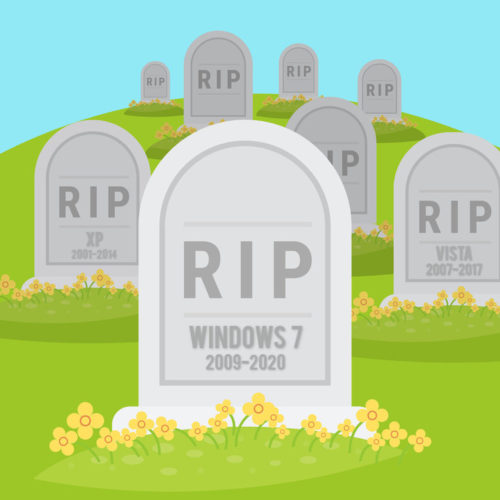Even though Windows 7 was released nearly a decade ago, it’s still incredibly popular with over 35% of PCs running on the aging operating system. However, your days with this tried and true OS may be numbered. Microsoft ended mainstream support (including new features and warranty claims) for Windows 7 way back in 2015, but extended support will be ending in January. If you’re currently running Windows 7, you may have even recently started seeing Windows 7 End of Support reminders pop up on your computer.
Late last year, we ran down some of the impacts to your business in our post, The Lowdown on Windows 7 End of Support. As January 14, 2020 looms closer, we want to circle back on what this means for you and how we can help.

What does it mean?
End of support, or end of life (EOL), indicates the end of a product’s useful life and end of manufacturer sale/support. Once January 14th rolls around, Microsoft will no longer provide updates or free support for the Windows 7 operating system.
Of course, if you prefer to live life on the wild side, you could still continue to use the outdated OS. Just know that your computer will no longer receive security updates and patches to keep pace with emerging threats so you’re opening yourself up to a varied cornucopia of malware. There’s even a good chance that those with malicious intent, fully aware that aging devices are unprotected, will specifically target Windows 7 users.
If Microsoft stops supporting its own software, that’s also a signal to other software providers to stop. It may not happen immediately, but eventually most third-party software and programs, like Google Chrome, will stop working with your Windows 7 devices.
Even though extended support is ending, Windows 7 Professional and Windows 7 Enterprise customers with volume licensing will be able to purchase extended security updates (ESUs) through January 2023. But it’ll cost you. A lot. According to Techspot, the first year of ESUs (January 2020 to 2021) will cost those using Windows 7 Enterprise $25/device. This doubles to $50 in the second year and goes up to $100 for the third year. For those of you using Windows 7 Pro, ESUs will start at $50/device before increasing to $100 in year two then $200 in year three. Ouch.
How can ADKtechs help?
You can eat pizza and hamburgers every single day for the rest of your life (yum), but your doctor would probably agree that just because you can, doesn’t mean you should. Just because you can continue to use Windows 7, doesn’t mean you should. In fact, we highly advise against it.
Luckily, you have another, cost-saving option – upgrading. If you’re into saving time and money (who isn’t?!), it just doesn’t make sense to keep outdated software, especially when Windows 10 is such a great alternative. According to our partners over at Microsoft, “Windows 10 is the most secure Windows ever built, with comprehensive end-to-end security that covers antivirus, firewall, internet protections, and more. This means more security features, dashboard displays, and ongoing updates to help safeguard against future threats—all built-in at no extra cost”.
Generally speaking, since both Windows 7 and Windows 10 are made by Microsoft, upgrading is a fairly simple process with minimal downtime. There are two options when it comes to upgrading. You could just upgrade your operating system and keep using your computer that’s probably quite a few years old. Or you could purchase a new Windows 10 computer.
Running a newer operating system on an older device will only lead to frustration. To take advantage of the latest speed, security, and hardware functionalities while staying compatible with the latest industry innovations, we suggest treating yourself to a new computer. Check out how Windows 10 security stacks up by clicking here.






